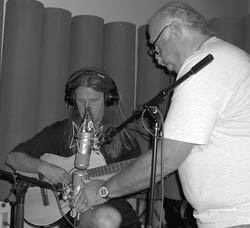
Studio Tube Traps
I also always take my Studio Tube Traps with me to my recording sessions.
I have the traps that are 53 inches high and 9 inches in diameter.
The Studio Tube Trap is adjustable for height. Each trap actually has two sides with little marks to identify them; one side is reflective and the other is absorptive.
In many recording situations, I don’t pay too much attention to those little marks. In other words, I don’t carefully organize them, aimed in one direction, or face them all in one neat little row, or something. I generally make a random Tube Trap set-up.
I’ll try to make the room sound as natural as I can. I usually put the Traps more towards the outside perimeter of the room and not between the sound source and the microphone.
If the room has an area that might be perhaps too reverberant, or if I hear a reflection or a standing wave I don’t like, or if the area I want to record or mix in is simply too sonically belligerent, I can use my Tube Traps to immediately modify the sound-field.
I find that Tube Traps make a dramatic difference. In this situation, I always pay attention to those marks that identify which side is reflective and which side is absorptive.
You can experiment by starting out with a lot. Then just remove them two at a time – you will hear the sound liven up incredibly. They allow you the ultimate control of the room reflections mixed in with the direct sound. It’s like having moveable walls.
I have used my Tube Traps in an array around Michael Jackson when I recorded every one of the vocal tracks on all of his albums since (Michael Jackson’s) Bad. The acoustic space created by the Traps allows for consistency of sound at the mike, regardless of position shifts on the part of the performer.
I find the Studio Traps particularly useful for recording an artist like Michael Jackson because Michael always dances as he sings, even when he’s recording. This combination helps create at the mike a dense pattern of early reflections on both the vocal and the footstep sounds.
My plywood drum platform (when I use it for recording Michael’s vocals), together with the Studio Traps, makes Michael’s dancing footsteps a distinctive element of the rhythm track.
